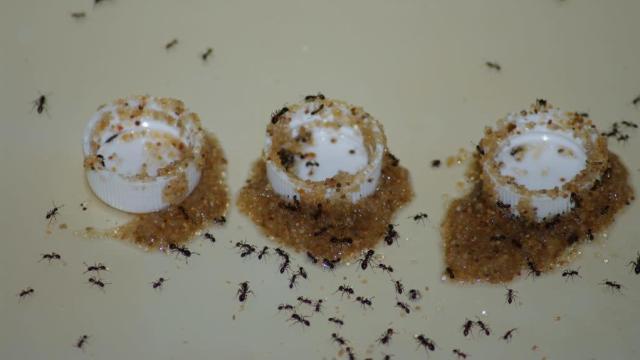A species of fire ant can turn tiny grains of sand into a powerful tool for extracting food, in a clever design meant to reduce drowning risk.
Humans, apes, crows, elephants, sea otters and other vertebrates are known tool users. Insects, not so much. Indeed, very few invertebrates have displayed this capacity, which is often taken as a sign of low intelligence. This lack-of-ability suggests bugs are inflexible, rule-based creatures incapable of thinking outside the box.
Some insects, like black imported fire ants (Solenopsis richteri), have displayed a tool-building capacity, using grains of sand as a tool while foraging for solid food. This species is native to South America, but they’ve become an invasive species in the southern U.S.
A research team led by Aiming Zhou, an associate professor at Huazhong Agricultural University in China, had a hunch that black imported fire ants can adapt their tool use in the face of risks. To test this assumption, they set up an experiment to see how the fire ants might adjust their tool use in response to foraging risks, namely an increased chance of drowning. Their results form the basis of a new study published this week in Functional Ecology.
For the experiment, the researchers filled several small bottle cap-like containers with sugar water, which is irresistible to ants. For fire ants in the wild, the equivalent food source would be nectar and honeydew, which provides them with a delicious source of carbohydrates.
All things being equal, the ants would normally dive right in and guzzle the sugar water while skimming the surface of the bath — a feat made possible by their water-resistant exoskeletons. Knowing this, and wanting to make their lives considerably more difficult, the researchers added a non-toxic surfactant to the sugar water. This significantly reduced the water’s surface tension, taking away the ants’ aquatic super powers. And indeed, the added surfactant did result in an increased proportion of drowned ants, as the authors explained in the new study.
The drowning risk presented an existentially dangerous obstacle for the foraging ants. Lucky for them, the scientists provided the fire ants with a familiar resource in the form of sand grains. Normally, these ants use sand to retrieve solid foods, but in this case they used the sand to acquire liquid food — a rare skill even among vertebrates. By piling the sand around the containers, the ants were able to syphon the sugar water from the food container.
The sand structure, soaked up water like a sponge, providing safe access for the ants. In tests, the ants could syphon nearly half of the sugar water from the containers in just five minutes. And in addition to reducing the risk of drowning, the sandy structure also provided a larger working space for the ants to collect their sugar water. Importantly, the ants didn’t build the sandy structures when offered sugar water not laced with the surfactant.
Jian Chen, an entomologist at the U.S. Department of Agriculture and a co-author of the new study, said in a statement that his team was “surprised by such remarkable tool use displayed by black imported fire ants.” The new findings “suggest that ants and other social insects may have considerable high cognitive capabilities for unique foraging strategies,” he added.
[referenced id=”956773″ url=”https://gizmodo.com.au/2016/04/life-rafts-made-entirely-from-ants-are-surprisingly-sophisticated/” thumb=”https://gizmodo.com.au/wp-content/uploads/2016/04/20/zxdtzuef4hftlzonfjyu-300×169.jpg” title=”Life Rafts Made Entirely From Ants Are Surprisingly Sophisticated” excerpt=”Ants are amazing at co-operation, using their bodies to form parts of chains, ladders, walls and even rafts. A new study shows that the rafts built by ants are surprisingly well organised, the product of specialised skills and complex memorisation tasks.”]
But as the authors pointed out in their paper, “more detailed studies are needed to elaborate on the universality of the flexibility of ants in tool use strategies under varying environmental constraints.”
Indeed, the current study was limited to the black imported fire ants, and it would be interesting to see if other ant species have adopted similar strategies and are capable of leveraging their tools when confronted with dangerous situations. It’s also possible that the ants were simply trying to build a structure around the containers to improve safe access to the sugar water given the heightened drowning risk, and that the syphoning effect was purely accidental. Future experiments should try to rule this out. Regardless, the new study does point to complex, flexible, and innovative tool-using behaviours among social insects.
This isn’t the first study to investigate anti-drowning tactics employed by ants. Back in 2016, researchers from the University of California, Riverside showed that European Formica selysi ants will link their bodies together to create life rafts, in a process known as self-assembly.
